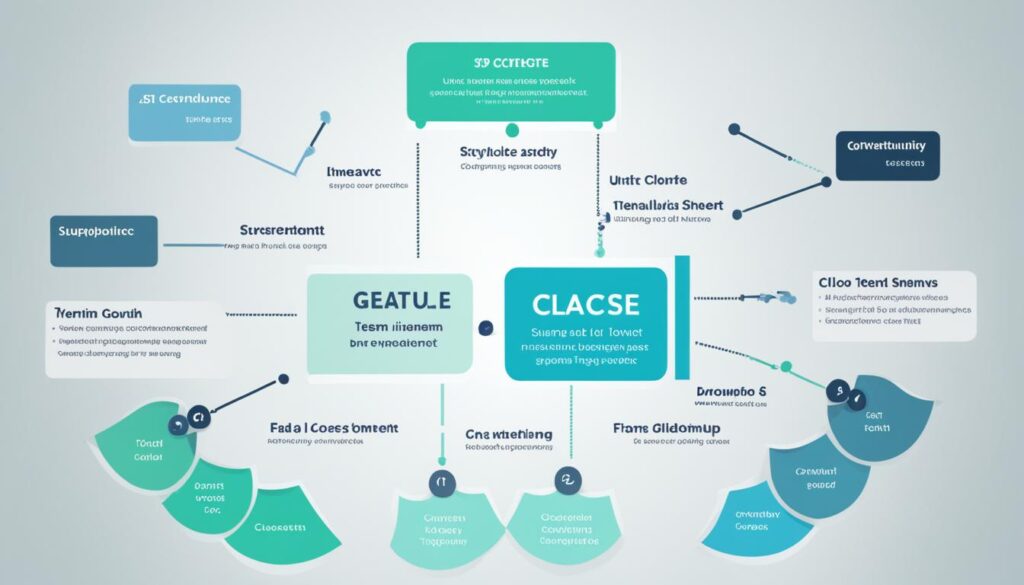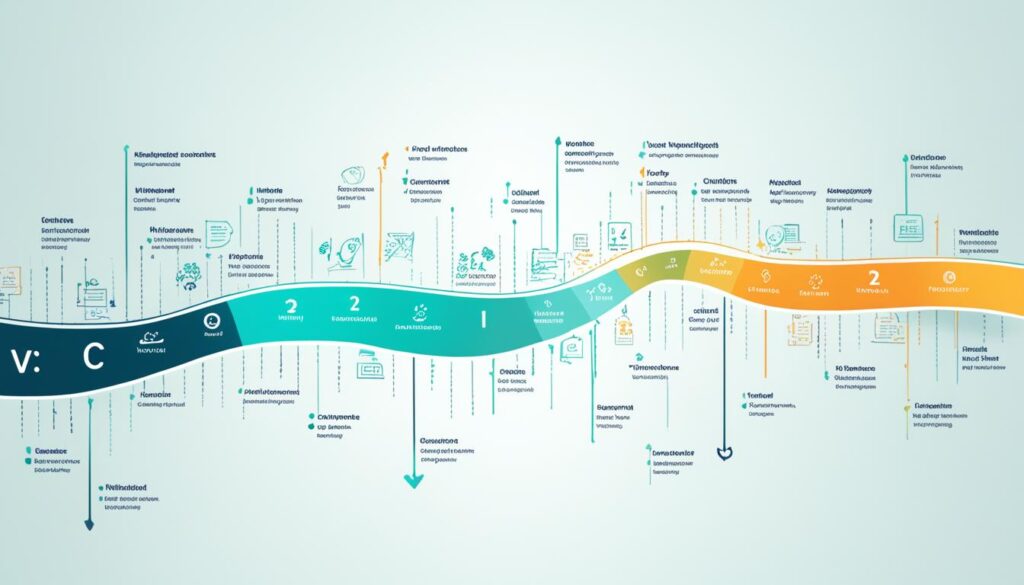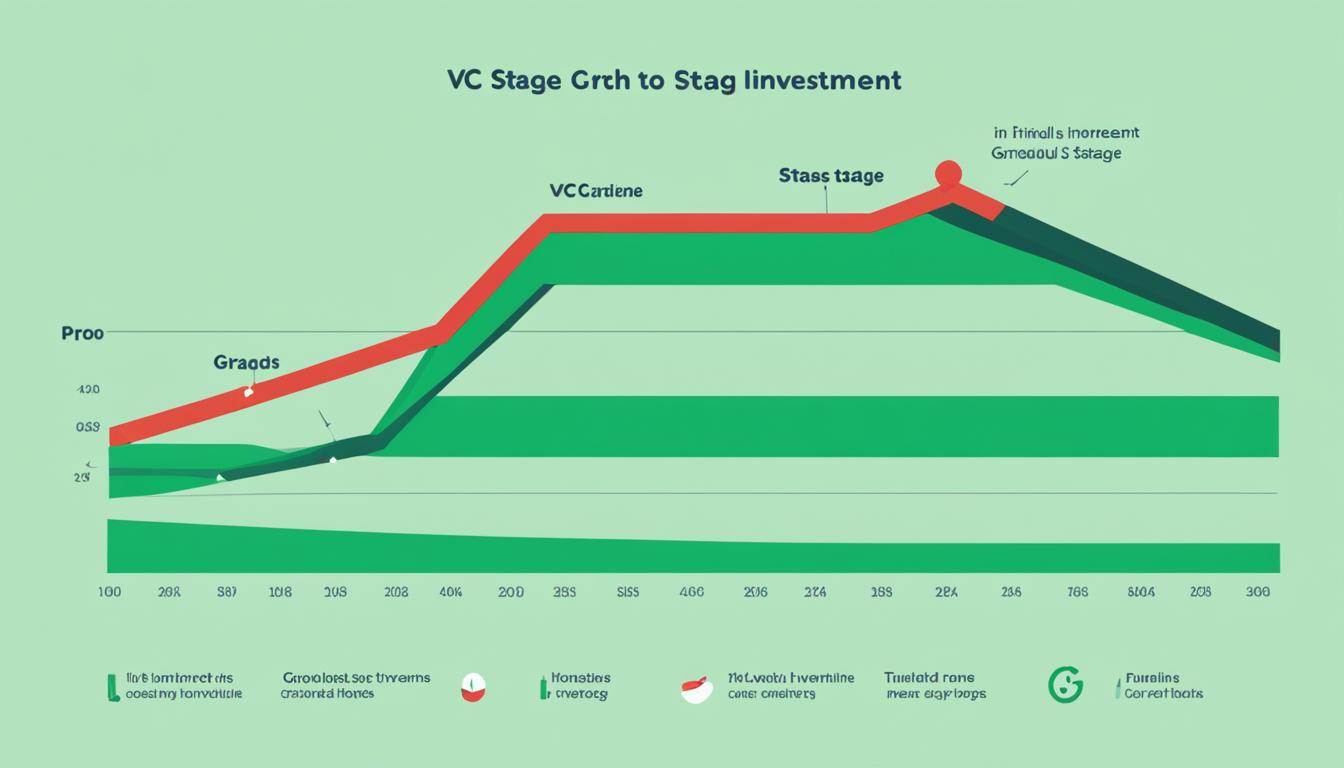Understanding venture capital (VC) can be daunting. Investors spend time really thinking about startups. They want to see big growth potential before putting in money. This guide delves into the steps of VC investing. It’s for both entrepreneurs and investors. They can learn what to look out for when going after VC funds.
Everyone wonders about How long it takes for a startup to get VC funds and what comes next? This article explains the usual timeline from first contact to more funding or selling the startup. Knowing this process helps startup owners get ready. It lets them move through the VC world with more success.
Key Takeaways
- A typical VC investment timeline involves several stages, from sourcing deals to exiting investments, that can span several years.
- The VC investment process includes initial screening, due diligence, deal negotiation, and term sheet finalization.
- The timeline can vary depending on the stage of the startup, the industry, and the investment strategy of the venture capitalist.
- Startups need to be well-prepared to make a successful pitch and manage expectations throughout the VC investment process.
- The post-investment relationship between startups and venture capitalists is crucial, with ongoing support and follow-on funding opportunities.
Understanding the Venture Capital Investment Process

Venture capital (VC) is funding from investors, usually firms or funds, for early-stage or high-growth companies. In return for the investment, these investors get a share of the company. This is key for startups to get off the ground and grow.
What is Venture Capital?
Venture capital is a special kind of investment money that goes to startups and small businesses with big potential. Venture capitalists don’t just give money. They also share their knowledge, help with strategy, and introduce companies to others in the industry. Their main aim is to make a big win through things like IPOs or acquisitions.
The Role of Venture Capitalists
Venture capitalists (VCs) are the experts who handle these big investment funds. They actively search for the best startup chances. Besides financing, they’re like business partners. They give smart advice, connect startups with important people, and lend a hand where needed. They are vital for the growth and innovation of the venture capital world.
Stages of a Typical VC Investment Timeline

The process of investing in a startup through venture capital has several steps. These steps include looking for deals, doing deep research, and working out the details of the investment.
Sourcing and Initial Screening
It all starts with venture capitalists looking for interesting startups. They do this by using their connections and knowledge of different industries. They also use various tools to find good investment chances. They look at things like what the startup does, how it might grow, who is leading it, and how it fits the VC firm’s goals.
Due Diligence Process
After spotting a potential investment, the VC firm dives deep into it. They look closely at its finances, place in the market, competition, technology, and people running it. This step lets the venture capitalists check if the startup is as promising as it seems and see what problems might come up.
Deal Negotiation and Term Sheets
If the startup comes out well from the due diligence, it’s time to negotiate the terms of the investment. This includes deciding how much the startup is worth, what part of it the VC firm will own, and preferences for how money will be given back if the startup doesn’t make it. The term sheet is then signed, which lists the most important parts of the deal.
The VC investment process is meant to help both the investors and the startups. It gives needed money to the startups and aims to make sure the investors’ money is used well. Entrepreneurs can use knowledge about these steps to better prepare for getting funding from VCs.
What is a typical VC investment timeline?

VC investment timelines differ based on the startup’s stage and the VC’s strategy. It’s key to know the timeframes for early and later stages. This insight helps understand the entire investment journey.
Early-Stage Investments
For startups in seed or Series A stages, early-stage VC funding is vital. It helps in the product development, team building, and finding a solid business model. These rounds last 6 months to 2 years. VCs guide the startup closely to meet key goals.
Later-Stage Investments
Late-stage VC backing comes when a startup has grown. It aims to help the company scale, enter new markets, or get ready for a big move like an IPO or buyout. This process spans 12 to 24 months. VCs and the management team work together to grow the company.
Factors Influencing the Investment Timeline

A VC’s decision to invest is affected by several elements. These include the area the business focuses on. The team leading the startup, and what kind of investments the venture capitalist prefers are also key.
Industry and Market Conditions
The setting where a startup grows influences how quickly they get funded. This includes factors like the market’s size, how much it can grow, and what other companies are doing. Also, rules and regulations can slow things down. For instance, tech companies might get funding faster than heavily regulated ones.
Founder Experience and Team Composition
VCs like to see a skilled team driving the startup. Founders who have achieved before and understand their field well stand out. A diverse, well-rounded team can also speed up the investment process.
Investment Strategy and Focus Areas
What a VC’s focuses on and their preferred investment goals matter. They might target specific industries or only invest at certain stages. This can add time to the decision-making process. The size and complexity of the investment can also affect timing.
| Factor | Impact on VC Investment Timeline |
|---|---|
| Industry and Market Conditions | Fast-paced, high-growth industries may secure funding more quickly, while regulated industries face longer timelines. |
| Founder Experience and Team Composition | Experienced founders with complementary teams can expedite the investment process, demonstrating readiness and scalability. |
| Investment Strategy and Focus Areas | VCs with specific industry or stage preferences, as well as investment capacity, can impact the timeline. |
Knowing these elements can aid entrepreneurs in tackling the VC investment timeline. This knowledge could help them secure the funds required to grow their ventures.
Managing Expectations and Timelines

Understanding the VC investment timeline is tough for both startups and venture capitalists. They need to handle their expectations and timelines well. It’s key for startups to realize the VC funding process is long. Plus, it’s the start of a lasting bond with their investors.
Venture funds work within a 10-year plan to use their funds and make profits for investors. This timeline might get a 2-3 year extension. Partners in these funds could be busy with 3 to 6 projects each. They often put most of their money into the next rounds of investment.
About 30% of the total investment goes into the first round by VCs. These funds usually aim to work with 9 to 18 companies. They pick most of these companies within the fund’s first 1.5 to 3 years. Skilled VC investors might own 15-25% of a company in the end.
Knowing these details helps startups get ready for the VC funding journey. It’s important for them to collaborate and communicate well with investors. This makes reaching common objectives more likely. Such teamwork can lead to a positive and beneficial partnership over the investment’s course.
Preparing for a Successful VC Pitch

To win over venture capitalists, startups must be well-prepared. They need a strong business plan and financial projections. Plus, presentation and storytelling skills are key. These can show the startup’s goal, the market’s potential, and how they plan to grow.
Business Plan and Financial Projections
Having a detailed business plan and financial projections is crucial. VCs will check your company’s financial health, the market, and how you plan to scale. Your plan should prove you know the market well. It should highlight what makes you unique and how you will fulfil your vision.
Showing your financial needs and growth capability is also important. Your financial projections should be reasonable and based on solid research. They should support your business’s overall strategy.
Presentation and Storytelling Skills
Along with a solid business plan and financial projections, good presentation and storytelling skills are vital. VCs want to hear not only about your business model but also a captivating story. This should reveal your startup’s core and prospects for growth.
Being a good presenter and storyteller can make your audience buy into your vision. Work on your pitch to make it engaging and memorable. Make sure your message is clear, and your delivery is smooth.
By focusing on these aspects, startups can better their chances of getting the funding they need. This injection of cash can drive their business forward and help reach their growth goals.
Post-Investment Relationship and Milestones

The venture capital (VC) investment doesn’t end after the first fund. Venture capitalists stay involved with their investments. This support includes helping companies reach important goals.
Board Participation and Governance
Venture capitalists often take part in the board of the companies they invest in. They offer strategic advice, keep an eye on progress, and ensure the company goes in the right direction. This helps companies face problems, find opportunities for growth, and maintain good governance.
Follow-on Funding and Exit Strategies
VCs might offer more money for companies to grow, expand, or explore new ventures. This extra funding depends on the company’s success in meeting set goals. The main aim for VCs is to find companies that can leave the market in a big way, like getting bought or going public, and make money for their investment.
Case Studies and Success Stories

We’ll look at some key examples to explain the VC investment timeline. This will include VC investment timeline case studies and VC investment timeline success stories.
Airbnb is a great example. It started in 2008 with $20,000 from Y Combinator. From there, it grew, raising $7.2 million in a Series A in 2009 and $112 million in a Series B in 2011. The highlight was its IPO in 2020, marking a major success story.
Then, there’s Slack. Founded in 2013, it got a $17 million boost in 2014. It continued to attract investments, securing $120 million in 2014 and $200 million in 2017. It went public in 2019, showcasing the power of venture capital for startups.
| Company | Year Founded | Initial Seed Funding | Subsequent VC Rounds | Exit Event |
|---|---|---|---|---|
| Airbnb | 2008 | $20,000 from Y Combinator | $7.2 million Series A (2009), $112 million Series B (2011) | IPO (2020) |
| Slack | 2013 | $17 million Series A | $120 million Series B (2014), $200 million Series E (2017) | Public Listing (2019) |
These examples show venture capital’s influence on startups. By following the VC investment timeline, they achieved great success. This funding and support helped them grow, leading to their successful exits.
Conclusion
In summary, the VC investing process is full of twists and turns. It starts with spotting potential deals and ends with exiting those investments. The time it takes to complete this journey can change a lot, based on the startup’s stage and the VC’s plan.
This guide has looked at how VCs find, examine, and choose deals. We’ve also talked about the impact of different markets, a founder’s background, and where the VC is putting its money. All these factors play a big role in how long the process takes.
For both startups and VCs, handling expectations and time frames properly is key. Startups should focus on making a solid business plan, improving how they tell their story, and understanding what comes after the money. These efforts can help startups get the funding they need and work well with their investors over the long haul.
